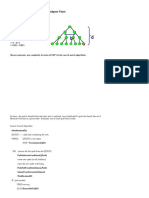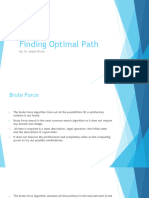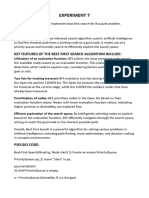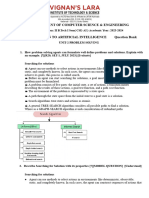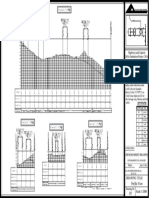Exercises: Artificial Intelligence
A*
�A*
A* ALGORITHM
� A* Algorithm
• Input:
– QUEUE: Path only containing root
• Algorithm:
– WHILE (QUEUE not empty && first path not reach goal) DO
• Remove first path from QUEUE
• Create paths to all children
• Reject paths with loops
• Add paths and sort QUEUE (by f = cost + heuristic)
• IF QUEUE contains paths: P, Q
AND P ends in node Ni && Q contains node Ni
AND cost_P ≥ cost_Q
THEN remove P
– IF goal reached THEN success ELSE failure
�A*
FIRST EXAMPLE ON A*
� A* algorithm by Example
f = accumulated path cost + heuristic
0
7 S 7
QUEUE = path containing root
QUEUE: <S>
7 5
S C
1 1 6 5
9
9 12
10 A B G 0
� A* algorithm by Example
f = accumulated path cost + heuristic
S Remove first path, Create paths to all
children, Reject loops and Add paths.
1 1
Sort QUEUE by f
10 A 11
9 B 10
QUEUE: <SB,SA>
7 5
S C
1 1 6 5
9
9 12
10 A B G 0
� A* algorithm by Example
f = accumulated path cost + heuristic
S Remove first path, Create paths to all
children, Reject loops and Add paths.
1
Sort QUEUE by f
10 A 11 B
QUEUE: <SA,SBC,SBG,SBA>
10 7 13
10 A 20
5 C 12
0 G 13 7 5
S C
1 1 6 5
9
9 12
10 A B G 0
� A* algorithm by Example
f = accumulated path cost + heuristic
S IF P terminating in I with cost_P &&
Q containing I with cost_Q AND
1
cost_P ≥ cost_Q THEN remove P
10 A 11 B
QUEUE: <SA,SBC,SBG,SBA>
10 7 13
10 A 20
5 C 12
0 G 13 7 5
S C
1 1 6 5
9
9 12
10 A B G 0
� A* algorithm by Example
f = accumulated path cost + heuristic
S Remove first path, Create paths to all
children, Reject loops and Add paths.
Sort QUEUE by f
A B
QUEUE: <SBC,SBG,SAB>
10 7 13
9 B 19
5 C 12
0 G 13 7 5
S C
1 1 6 5
9
9 12
10 A B G 0
� A* algorithm by Example
f = accumulated path cost + heuristic
S IF P terminating in I with cost_P &&
Q containing I with cost_Q AND
cost_P ≥ cost_Q THEN remove P
A B
QUEUE: <SBC,SBG,SAB>
10 7 13
9 B 19
5 C 12
0 G 13 7 5
S C
1 1 6 5
9
9 12
10 A B G 0
�A* algorithm by Example
f = accumulated path cost + heuristic
S Remove first path, Create paths to all
children, Reject loops and Add paths.
Sort QUEUE by f
B
QUEUE: <SBCG,SBG>
13
C 0 G 13 7 5
S C
1 1 6 5
12 9
0 G 12 10 A 9
B 12
G 0
�A* algorithm by Example
f = accumulated path cost + heuristic
S IF P terminating in I with cost_P &&
Q containing I with cost_Q AND
cost_P ≥ cost_Q THEN remove P
B
QUEUE: <SBCG,SBG>
13
C 0 G 13 7 5
S C
1 1 6 5
12 9
0 G 12 10 A 9
B 12
G 0
�A* algorithm by Example
f = accumulated path cost + heuristic
S SUCCESS
B
QUEUE: <SBCG>
C 7 5
S C
1 1 6 5
12 9
0 G 12 10 A 9
B 12
G 0
�A*
PROBLEM
� Problem
• Perform the A* Algorithm on the following
figure. Explicitly write down the queue at each
step. 10
A 6
4
6
17 13 6
E 4
1 0
5 3
S B 2
F G
7
10 4
D 6
C 6
�A*
A* SEARCH
� A* Search 10
0 A 6
4
17 S 17
17
6
5 13 6 E 4
1 3 0
S B 2 F G
7 D 6
10 4
C 6
QUEUE:
S
� A* Search 10
A 6
4
S 17
6
5 13 6 E 4
1 3 0
S B 2 F G
7 D 6
10 4
6 5 10 C 6
10 A 16
13 B 18
4 C 14
QUEUE:
SC
SA
SB
� A* Search 10
A 6
4
S 17
6
5 13 6 E 4
1 3 0
S B 2 F G
7 D 6
10 4
6 5 C 6
10 A 16
13 B 18 C QUEUE:
SA
16
2 D 18 SCD
SB
� A* Search 10
A 6
4
S 17
6
5 13 6 E 4
1 3 0
S B 2 F G
7 D 6
10 4
5 C 6
A 13 B 18 C QUEUE:
SAE
12 16
4 E 16
2 D 18 SCD
SB
� A* Search 10
A 6
4
S 17
6
5 13 6 E 4
1 3 0
S B 2 F G
7 D 6
10 4
5 C 6
A 13 B 18 C QUEUE:
SAEF
16
E 2 D 18 SCD
SB
18
B 31
16
F 17 SAEB
13 1
� A* Search 10
A 6
4
S 17
6
5 13 6 E 4
1 3 0
S B 2 F G
7 D 6
10 4
5 C 6
A 13 B 18 C QUEUE:
SCD
16
E 2 D 18 SB
SAEFG
F SAEFD
22 19
2 D 24
0 G 19
� A* Search 10
A 6
4
S 17
6
5 13 6 E 4
1 3 0
S B 2 F G
7 D 6
10 4
5 C 6
A 13 B 18 C QUEUE:
SB
E D SAEFG
SCDF
F 23
B 36
22
F 23 SCDB
13 1
19
0 G 19
� A* Search 10
A 6
4
S 17
6
5 13 6 E 4
1 3 0
S B 2 F G
7 D 6
10 4
C 6
A B QUEUE:
SBD
12 11
E 2 D 14
4 E 15 SBE
SAEFG
F
19
0 G 19
� A* Search 10
A 6
4
S 17
6
5 13 6 E 4
1 3 0
S B 2 F G
7 D 6
10 4
C 6
A B QUEUE:
SBE
11
E D 4 E 15 SBDF
SAEFG
F 18
C 22
18
F 19 SBDC
4 1
19
0 G 19
� A* Search 10
A 6
4
S 17
6
5 13 6 E 4
1 3 0
S B 2 F G
7 D 6
10 4
C 6
A B QUEUE:
SBEF
E D E SAEFG
SBDF
F 18
C 22
18
F 19
17
A 27
15
F 16 SBDC
4 1 10 1
SBEA
19
0 G 19
� A* Search 10
A 6
4
S 17
6
5 13 6 E 4
1 3 0
S B 2 F G
7 D 6
10 4
C 6
A B QUEUE:
SBEFG
E D E SAEFG
SBDC
F 18
C 22
17
A 27 F SBEFD
4 10
SBEA
19 21 18
0 G 19
2 D 23
0 G 18










